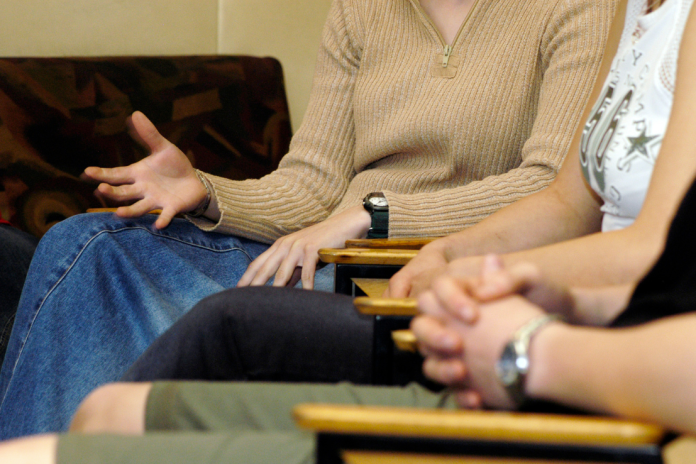There are different types of communication and nonverbal communication is a big part of it. When you communicate verbally, you will still use your body language. Body language can help you to understand what someone is thinking or feeling. The way that you sit, the posture, tone of your voice, volume and other things can help you to understand the intent of people.
Meaning of Body Language
People don’t always realize that body language communication is important. The way that someone moves and acts without saying anything can tell you how they are feeling. You need to use your intuition to read the non-verbal cues.
You can learn to understand body languages and you can pick up on clues of what someone is thinking or feeling.
Research can show you how to read nonverbal communication in the body and the face. People will express themselves through verbal and nonverbal communication. The great thing about body language is that it is a universal way of communicating. A smile always means a smile in every culture.
Reading Facial Expressions
When you ask someone if they like something or if they think something is good, you can read their facial expression and you will know by how their face looks if they like it or not. If someone is squinting or their head is furrowed, this can mean that they don’t like something. The tone of their voice can also tell you if they want to talk about something or not.
When you don’t believe someone, pay attention to how they are acting in their nonverbal language and if they are talking quietly or if they have lowered their tone. You can ask more questions to find out if you are reading them right.
Eyes
Here are some of the eye expressions that can tell you about how someone thinks or feels when you are talking to them:
Eye Contact
One way that you can tell if someone wants to talk to you and if they are interested in the conversation is if they make eye contact with you. Sometimes people will blink and look away for a short second and this is okay because you don’t want someone to stare at you without doing this because it can mean they are threatening.
Blocking
Eye blocking is when someone blocks their eyes. This can be them rubbing their eyes, closing the eyes often or blocking or turning away. Eyelids that are closed tightly can mean someone is trying to block out something you are saying that is negative.
Blinking
Bliking a lot can mean that the person talking to you is nervous. This can happen when you ask a question, and the person is lying to you.
Wide Opened Eyes
A person that opens their eyes wide are waiting to have you tell them something good. They are feeling positive towards you, and they are interested in what you are saying.
Flashing
Flashing the eyebrows or raising them can mean that someone is interested in your conversation, or they might be greeting you in a friendly way.
Raising the Eyebrows
Raising the eyebrows can show that the person isn’t sure about what you are saying. When both are raised and they are nodding, this can show that they agree with something that you said or that they have never heard of what you were saying before. When the brows are lifted for a while, this can be a positive feeling.
Smiling with the Eyes
You can tell if someone is smiling a real smile by how their eyes are. People normally smile with their eyes and when they squeeze their eyes together and there are wrinkles then you can tell that they smile a lot.
Mouth
You can tell about how a person is feeling by how their mouth is. Here are some examples:
- Disappearing lips. When someone makes their lips disappear by smiling and sucking them in the teeth it can mean they ear stressed. When someone is talking to you and they do this, they might get louder because they are getting stressed. This can also happen during interviews.
- Puckering lips. Puckering lips can mean that the person doesn’t agree with what you said. They might add other language like rolling their eyes, sighing, flaring their nostrils, sneering or more.
- Forehead frowning. When the forehead frowns, it can mean that you are anxious or sad.
- Tilted head. This happens when someone is trying to figure out what you are saying, or they are interested in what you say.
- Rubbing the neck. This can mean that you are stressed or insecure.
- Hunching. A person that hunches their shoulders can mean that they are closed off to you.
Emotional Energy
The tone of the voice can tell a lot about what someone is saying. An empath is able to use their gifts to get information from someone that is speaking. They can pick up on the emotions and the feelings by their tone. Some people will react to your tone or your voice with other cues.
Actions
The face will tell you things about what you are feeling even more than the rest of the body. Nonverbal communications come from the brain, and you can learn to control the way that you talk to someone by controlling things with your body language.
If you don’t realize that someone is feeling, then you aren’t using the body language of others to be able to understand the world around you. This is ineffective if you want to have good communication.
Fight or Flight
When someone is in a conversation and you see them freeze, fight or flight, this can mean that they are being defensive. Freezing is the first part of this, and the body will become defensive and, in a posture, when they feel that they are going to be in trouble.
Some people will try to get away from the conversation and this is flight mode. They might also use their nonverbal to show this by standing closed off, rubbing the eyes, blocking their eyes or other ways to get away from the conversation.
Fighting is the other stage and when someone feels that they are being talked to wrongly, they might become emotionally aroused and they might choose to confront you and to gain control of their emotions. People that aren’t in control of their emotions should never have these kinds of conversations.
Posture
Posture is an important thing to take notice of when you are having a conversation. People that take up a lot of space will usually claim their area, and this shows that they want to have their own area.
There is power in how you hold your posture and if you sit up straight then you will look more confident and empowered. This is how you are in control of your energy, and you can start feeling more powerful if you practice this kind of posture.
Crossing Legs and Arms
Women cross their legs out of habit, and this has to do more with posture than any kind of feelings. If someone crosses their legs or arms though, this can mean that they are closed off and guarded. A person that is relaxed and keeps their arms and shoulders opened, leaning forward, and using hand gestures means that they are open and engaged.
Crossing the arms can mean that someone is defensive, and they don’t agree with you, or they are not comfortable.
Here are some other signs of body language and communication:
- Fidgeting. You can tell someone is lying to you if they are fidgeting or if they are trying hard not to fidget. Look at their body posture and listen to the message.
- Handshake. A handshake that is equal to yours can mean that someone is powerful. You should notice if they are shaking your hand softly or if they aren’t gripping the same because this can show someone not being confident.
- Mirroring. A person that mirrors your body language is most likely interested in you. They want to copy you because they accept you and like you.
Body and Mind Connection
Your mind and your body are connected. The body language is controlled by your mind. The first thing that you need to do is to pay attention to what you are feeling and see how your body reacts to those feelings. Are you squinting, are you clenching your teeth? Once you learn to notice these things then you can learn what you look like when you are anxious or when you feel good.
You can learn to read yourself by paying attention to how you sit and your posture and what expressions that you have. People that are sad will know that they are feeling down, and they will describe this, but the body language will show this as well.
If you droop your shoulders or if you keep your head down, then you are probably showing depressive symptoms. The body and mind work together to control what you are feeling. You can smile and it can make you feel better but if you learn to control your body language and your posture then you will have stronger emotions and thoughts.
Reading Body Energy
Nonverbal body language is one way that you can read what someone is feeling or thinking. When someone blocks you by their body language, you can tell their energy is being blocked and they aren’t open to what you are saying to them.
If someone touches their ear, it can mean that they don’t want to hear what you are saying and if their arms are crossed it can mean they are cold. Listen to your intuition and let it guide you to what someone is trying to tell you.
If your words and your nonverbal behavior doesn’t match, you will see that the person is motivated to look like they are interested in what you are saying. Listen to your gut feeling and let it guide you to understanding.





This article offers an incredibly insightful exploration of nonverbal communication and its nuances. The detailed breakdown of gestures, facial expressions, and posture is profoundly enlightening. As someone deeply interested in the psychology of communication, I found the sections on eye contact and emotional energy particularly compelling. This piece is a must-read for anyone looking to enhance their understanding of human interactions!
The article does a good job of explaining how nonverbal communication complements verbal communication. It’s essential to consider both to fully understand the intent and feelings behind the message. Training ourselves to be more observant of these cues can certainly improve interpersonal interactions.
The section on reading facial expressions was particularly useful. It would be interesting to delve further into how these cues are processed by our brains and whether certain people have a natural aptitude for reading them.
It’s compelling to note how much our body language can convey, sometimes even more than our words. This article serves as a great guide for anyone looking to improve their communication skills, both in personal and professional settings.
The article provides an insightful breakdown of nonverbal communication, highlighting various aspects of body language such as facial expressions, posture, and eye movements. It’s fascinating to note how universally comprehensible certain expressions and gestures are, like a smile or eye contact, which transcend cultural barriers. Understanding these subtle cues can significantly enhance interpersonal communication and empathy, aiding in the accurate interpretation of others’ emotions and intentions. Moreover, the connection between body language and psychological states underscores the importance of self-awareness in managing one’s own nonverbal signals.
The article presents an insightful overview of nonverbal communication. It’s interesting to see how much can be gleaned from seemingly subtle clues, such as eye movements and posture. This highlights the importance of being more aware of these signals in everyday interactions.
I appreciate the detailed breakdown of different body language cues provided in the article. It’s a reminder of how nuanced human communication really is. However, I wonder if cultural differences might influence some of these interpretations.
That’s a good point. While certain gestures might be universal, like smiling, others can vary significantly across different cultures, which can lead to misunderstandings.
While the article provides a basic overview of nonverbal communication, it lacks depth in addressing cultural nuances that significantly affect body language interpretation. For instance, the claim that a smile is universally understood ignores the fact that in some cultures, smiling can convey discomfort or even be a sign of politeness rather than genuine happiness. The article would have benefitted from a more nuanced discussion that includes these cultural variances. Additionally, the simplistic reading of body language cues, like blinking and eye contact, can lead to misinterpretations. It’s essential to consider context and individual differences; some people may blink more due to medical conditions or may avoid eye contact due to cultural norms without any implication of dishonesty or nervousness. Understanding nonverbal communication requires a more sophisticated approach than the one presented here.